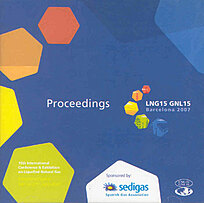
Quelques aspects des méthodes de calcul directes pour l'évaluation d'une structure de réservoir de GNL soumise aux impacts du liquide.
Some aspects of direct calculation methods for the assessment of LNG tank structure under sloshing impacts.
Auteurs : ZALAR M., MALECINA S., MRAVAK Z., et al.
Résumé
Industrial importance of vessels operating liquefied gas grows along with present LNG market expansion. Increased demand for new LNG transportation concepts requires larger vessel capacities and more flexible operation in partly filled condition. Consequently, it becomes indispensable to incorporate more rational methods in qualification procedure of new LNG designs. The paper deals with calculation methods necessary to put in practice for the evaluation of containment system and associated ship backup structure of LNG tanks in a membrane type of LNG vessels. Extremely complex problem of hydro-elastic interactions in the tank is reduced to the simplified ones; combining standard CFD tools (FLOW3D), conventional FEM tools (ABAQUS) and idealized hydrodynamic loading models based on asymptotic theories (Wagner, Bagnold, Korobkin etc.). Actually, direct fully-coupled methods, using commercial tools presently available on the market, do not seem capable to treat properly violent LNG sloshing impact events, for several practical reasons such as prohibitive CPU time, convergence problems, extremely complicated physics etc. Thus, the only practical way appears to be the composite approach which combines different tools which were independently validated for particular applications. Recent developments of Bureau Veritas Research Department are presented in this paper and their application to the practical situations discussed.
Détails
- Titre original : Some aspects of direct calculation methods for the assessment of LNG tank structure under sloshing impacts.
- Identifiant de la fiche : 2008-1136
- Langues : Anglais
- Source : LNG 15. Proceedings of the 15th International Conference and Exhibition of Liquefied Natural Gas.
- Date d'édition : 24/04/2007
Liens
Voir d'autres communications du même compte rendu (43)
Voir le compte rendu de la conférence
Indexation
-
Thèmes :
GNL et GPL;
Applications des gaz liquéfiés - Mots-clés : Calcul; Transport maritime; Réservoir; GNL; Construction
-
Pressure build-up type LNG carriers in LNG seco...
- Date : 29/09/2005
- Langues : Anglais
- Source : 1st International conference on small-scale LNG in Europe. Conference presentations [CD-ROM].
Voir la fiche
-
Economic design approach for small-scale tanker...
- Auteurs : GERDSMEYER K., ACHEROY D.
- Date : 29/09/2005
- Langues : Anglais
- Source : 1st International conference on small-scale LNG in Europe. Conference presentations [CD-ROM].
Voir la fiche
-
Case analysis of Norwegian intermediate LNG sto...
- Auteurs : JETLUND A. S., HEIERSTED R. S.
- Date : 29/09/2005
- Langues : Anglais
- Source : 1st International conference on small-scale LNG in Europe. Conference presentations [CD-ROM].
Voir la fiche
-
Advanced LNG carrier with energy saving propuls...
- Auteurs : OHIRA H., SUETAKE Y., OKA M.
- Date : 21/03/2004
- Langues : Anglais
- Source : LNG 14. Proceedings of the 14th international conference and exhibition of liquefied natural gas [CD-ROM].
Voir la fiche
-
TRANSPORT DU GAZ NATUREL LIQUEFIE.
- Auteurs : NULLMEIER E.
- Date : 09/1980
- Langues : Allemand
Voir la fiche
